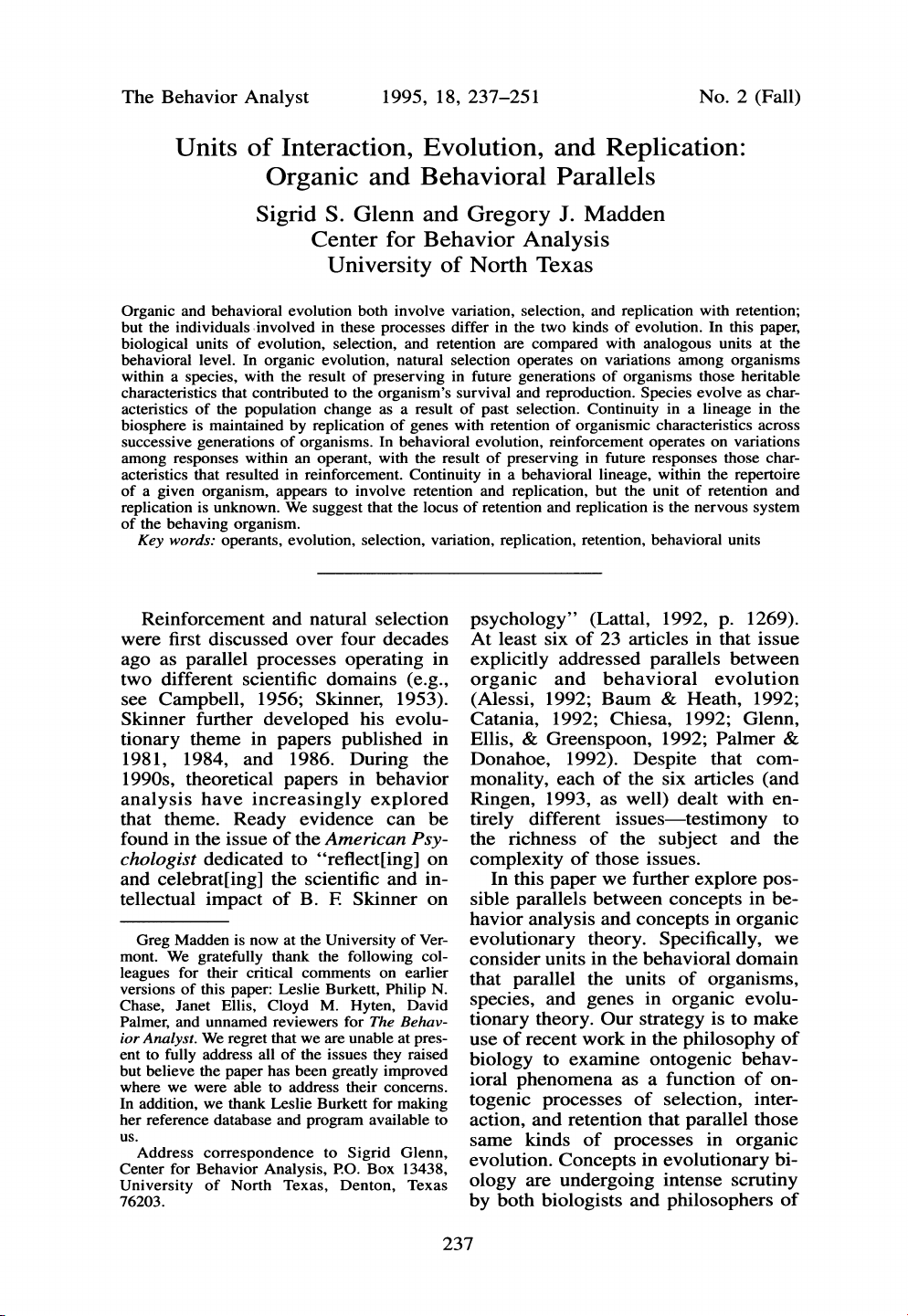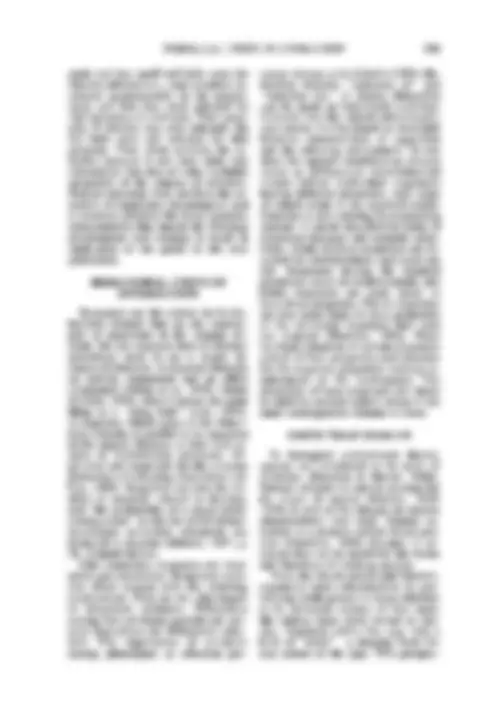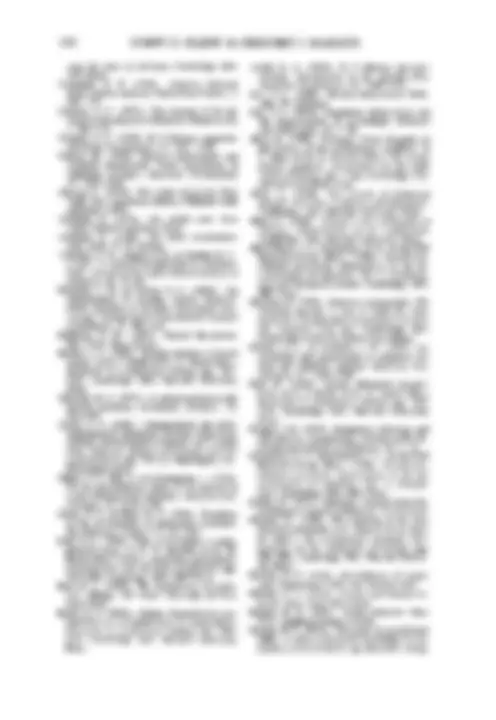











Study with the several resources on Docsity

Earn points by helping other students or get them with a premium plan


Prepare for your exams
Study with the several resources on Docsity

Earn points to download
Earn points by helping other students or get them with a premium plan
Community
Ask the community for help and clear up your study doubts
Discover the best universities in your country according to Docsity users
Free resources
Download our free guides on studying techniques, anxiety management strategies, and thesis advice from Docsity tutors
This paper compares biological units of evolution, selection, and retention with analogous units at the behavioral level. It explores possible parallels between concepts in behavior analysis and concepts in organic evolutionary theory. The paper examines ontogenic behavioral phenomena as a function of ontogenic processes of selection, interaction, and retention that parallel those same kinds of processes in organic evolution. The paper is authored by Sigrid S. Glenn and Gregory J. Madden from the Center for Behavior Analysis at the University of North Texas and was published in The Behavior Analyst in 1995.
Typology: Study notes
1 / 15

This page cannot be seen from the preview
Don't miss anything!










The Behavior Analyst 1995, 18, 237-251 No. 2^ (Fall)
Organic and behavioral evolution^ both involve variation,^ selection,^ and^ replication^ with^ retention; but the individuals involved in^ these processes differ^ in^ the^ two^ kinds^ of evolution.^ In^ this^ paper, biological units of evolution, selection,^ and retention^ are^ compared with analogous units^ at^ the behavioral level. In^ organic evolution,^ natural selection^ operates^ on^ variations^ among^ organisms within a species, with the result of preserving in future generations of organisms those heritable characteristics that^ contributed^ to^ the^ organism's^ survival and^ reproduction.^ Species^ evolve^ as^ char- acteristics of the population change as a result of past selection. Continuity in a lineage in the biosphere is maintained by replication of genes with retention of organismic characteristics across successive generations of organisms. In behavioral evolution, reinforcement operates on variations among responses within an operant, with the result of preserving in future responses those char- acteristics that resulted in reinforcement. Continuity in a behavioral lineage, within the repertoire of a given organism, appears to involve retention and replication, but the unit of retention and replication is unknown.^ We^ suggest^ that the^ locus^ of retention^ and^ replication^ is the^ nervous^ system of the behaving organism. Key words: operants, evolution, selection, variation, replication, retention, behavioral units
Reinforcement and natural selection were first discussed over four decades ago as parallel processes operating in two different scientific domains (e.g., see Campbell, 1956; Skinner, 1953). Skinner further developed his evolu- tionary theme in papers published in 1981, 1984, and 1986. During the 1990s, theoretical papers in behavior analysis have increasingly explored that theme. Ready evidence can be found in the issue of the American Psy- chologist dedicated to "reflect[ing] on and celebrat[ing] the scientific and in- tellectual impact of B. F Skinner on
Greg Madden is now at the University of Ver- mont. We gratefully thank the following col- leagues for their critical comments on earlier versions of this paper: Leslie Burkett, Philip N. Chase, Janet Ellis, Cloyd M. Hyten, David Palmer, and unnamed reviewers for The Behav- ior Analyst. We regret that we are unable at^ pres- ent to fully address all of the^ issues^ they raised but believe the paper has been greatly improved where we were able to address their^ concerns. In addition, we thank Leslie Burkett^ for^ making her reference database and^ program available^ to us. Address correspondence to^ Sigrid Glenn, Center for Behavior Analysis, P.O.^ Box^ 13438, University of North^ Texas, Denton,^ Texas
psychology" (Lattal, 1992, p. 1269). At least six of 23 articles in that issue explicitly addressed parallels between organic and behavioral evolution (Alessi, 1992; Baum & Heath, 1992; Catania, 1992; Chiesa, 1992; Glenn, Ellis, & Greenspoon, 1992; Palmer & Donahoe, 1992). Despite that com- monality, each of the six articles (and Ringen, 1993, as well) dealt with en- tirely different issues-testimony to the richness of the^ subject^ and the complexity of those issues. In this paper we further explore^ pos- sible parallels between concepts in^ be- havior analysis and concepts in^ organic evolutionary theory. Specifically,^ we consider units in^ the^ behavioral domain that parallel the^ units^ of^ organisms, species, and^ genes^ in^ organic^ evolu- tionary theory.^ Our^ strategy^ is^ to^ make use of recent^ work in the^ philosophy^ of biology to examine ontogenic behav- ioral phenomena as a^ function^ of^ on- togenic processes of selection, inter- action, and retention that parallel those same kinds of processes in organic evolution. Concepts in evolutionary bi- ology are undergoing intense scrutiny by both biologists and philosophers of
237
238 SIGRID S. GLENN & GREGORY J. MADDEN
biology who are sorting out conceptual muddles that have plagued evolution- ary theory since its inception (see, e.g., Ghiselin, 1974; Hull, 1989; Mayr, 1982; Sober, 1984). The work of those and other biologists and philosophers of biology may aid behavior analysts in exploring comparable issues in their own domain. Readers might reasonably ask "Why? What is the purpose of this ex- ercise?" One reason is that some of the most profound issues in (^) behavior anal- ysis have^ not^ been addressed in ways that have led to a (^) continuously devel- oping explanatory framework. (^) Some of the most (^) insightful explorations of the concept of the operant (e.g., Catania, 1973; Schick, 1971) do (^) not readily lend themselves to understanding the complexity that appears to characterize human behavioral repertoires. Because evolutionary theory has been highly successful in (^) explaining organic com- plexity, and because ontogenic behav- ior is seen increasingly as a product of selection processes of a second kind, the explanatory structure of evolution- ary theory could provide guideposts for developing a theoretical framework of similar power. The present effort is an attempt to examine some basic con- cepts from a different angle-one that is not inherently inconsistent with pre- vious views but that could lead to ex- amining those views from a new and useful perspective. Another reason for pursuing the top- ic is that viewing old concepts from a new perspective can stimulate new ap- proaches to research and application. Such has been the case in other sci- ences. New vocabularies, or at least re- vised meanings for old terms, can have a liberating effect on thinking, foster- ing reexamination of assumptions and accepted definitions. Systematic reex- amination of that kind could lead, as it has in^ evolutionary biology, to solu- tions to some long-standing conceptual impasses. In addition, it might foster new measurement (^) procedures, meth- ods, or^ environmental^ manipulations. Finally, if organic evolution and be-
havioral evolution involve the same kinds of processes, explication of those processes in either domain could pro- vide insight into recalcitrant problems in the other. This would be true even if the two domains were not substan- tively related to one another, as they are in the case of organic and behav- ioral evolution. Whether or not the present effort has any such direct ef- fects is less important to us than that it contribute to the process of reexami- nation.
The experimental analysis of behav- ior has sought from its inception to for- mulate principles that describe lawful relations between the behavior of or- ganisms and other observable events (Skinner, 1938). Those principles, like the (^) principles of other (^) sciences, are generalizations that are content free (cf. Lee, 1988). For example, the prin- ciple of reinforcement describes a cer- tain kind of relation that can be ob- served at the behavioral level. Specif- ically, the relation entails two parts-a response-consequence contingency and a resulting increase in the rate of the responding followed by that con- sequence. The principle does not spec- ify any particular activity or any par- ticular consequence. It is "a general- ization that [is] spatiotemporally unre- stricted [and] that refers to any entities that happen to have the appropriate characteristics" (Hull, 1984, p. 145). The appropriate characteristics in the case of the reinforcement principle are behavior-consequence relations that are functionally related to increased rate of responding. Accounting for observed phenome- na in terms of such principles is one kind of scientific explanation. For ex- ample, if we observe that a parent at- tends when a child is (^) whining but not when whining is absent, and we note
by invoking the^ principle of reinforce- ment. Such explanation is structurally
240 SIGRID S. GLENN & GREGORY J. MADDEN
word as appearing on only 3 of 858 pages. In a later text (in which fitness appears on 4 of 550 pages), Mayr seems to accept what "the average per- son knows" about its meaning: "It is the capacity of an organism to survive in a given environment or, in other words, to cope with the conditions of the environment" (Mayr, 1988, p. 128). Sober (1984) spends 225 pages disentangling fitness from the causal structure of selection processes in evo- lutionary theory. The result of that en- deavor is^ an^ analysis of selection^ as a causal process, whereas "fitness is causally inert" (p. 85), as he suggested at the outset of the discussion. Most theorists view natural^ selection as accounting "for the^ origin^ as^ well as the (^) spread of new variants or traits" (Endler, 1992,^ p. 220,^ italics^ in^ origi- nal). Three conditions define the pro- cess of natural selection: variation in some attribute of individuals that are members of a natural population; a consistent relationship between that at- tribute and survivorship, mating abili- ty, or both; the attribute must be ca- pable of being passed on to future in- dividuals (inherited) (Endler, 1992). One of the (^) topics of (^) ongoing debate in evolutionary biology has to do with the level at which selection occurs. The question typically posed is "What is the unit of selection?" The main con- tenders are genes, organisms, and pop- ulations (Brandon & Burian, 1984), and the proponents of the various an- swers seem to have had no success in persuading one another to change their views. Philosophers of biology and philosophically inclined biologists at- tribute the recalcitrance of the problem to other unsolved definitional issues, particularly the definition of selection. Hull (1989, chap. 6) suggested that^ se- lection involves two different kinds of entities: replicators and interactors.^ A replicator is "an entity that^ passes on its structure largely intact in^ successive replications," whereas an^ interactor is
whole with its environment in such a way that this interaction causes repli-
cation to be differential" (Hull, 1989, p. 96). Hull concluded that "genes are obviously the most fundamental repli- cators [in organic evolution]"^ (p.^ 98). In organic evolution, organisms are al- ways interactors (but not necessarily the only organic^ entities^ that interact with their environment). Hull's distinc- tion between replication^ and interac- tion is a distinction of function.^ He seems to be^ saying^ that selection pro- cesses (in the organic domain or any other) involve entities with replicating functions and entities with interacting functions (and some entities may func- tion both ways). Proponents of genic selection emphasize the role of repli- cation in natural selection. Biologists who are convinced that the organism is the unit of selection emphasize the in- teraction between organism and envi- ronment that determines whether or not genes are replicated in the next gener- ation. In short, Hull attributes their dis- agreement to a difference in proclivi- ties for focusing on either replication or interaction in the selection process. In sorting out the ways in which the term selection is used in evolutionary theory, Sober (1984) made another dis- tinction, different from Hull's but not incompatible. Sober distinguished be- tween selection of objects and selec- tion for properties. He used a child's toy to develop an analogy to explain that distinction. The toy is a transpar- ent cylinder with several compartments separated by horizontal filters, each having successively smaller holes in it than the one above. In the top com- partment are a number of balls of dif- ferent size, each size having a partic- ular color. Shaking the^ cylinder results in all the green middle-sized balls and the red small^ balls^ moving into the middle (^) compartment, while the large blue balls remain^ in the^ top compart- ment. Further (^) shaking results in only the red small balls moving into the lowest compartment. The smaller the balls, then, the^ more^ successful^ they are at (^) reaching the bottom (^) compart- ment (surviving). Sober (1984) uses^ this^ analogy to
PARALLEL UNITS IN EVOLUTION 241
point out that small red balls were the objects selected (i.e., their numbers in- creased proportionally in the popula- tion), and that they were selected for their property of smallness. Their^ prop- erty of redness^ was^ also^ selected, but the balls were not selected for that property. Thus, what survives the se- lection process is not only what was selected for but also all other heritable properties of the objects of selection. Natural selection, then, involves the se- lection of organisms (phenotypes); and it involves selection for those (genetic) characteristics that match the selecting environment well enough to result in replication of the genes in the next generation.
Responses are the entities in the be- havioral domain that are the counter- part of organisms in the organic do- main. We use response here as Skinner sometimes used it-as a single in- stance of behavior. A response includes an activity component and an effect component (Glenn et al., 1992; Glenn & Field, 1994). Here it means the same thing as a "thing done" (Lee, 1994). A response, which exists in the behav- ioral domain, is parallel to an organism in the organic domain, at least with re- spect to^ evolutionary processes. Or- ganisms and responses are the concrete particulars of everyday observation (cf. Lee, 1988). Responses are also the en- tities of practical interest to humans, and "the^ probability of^ a^ single forth- coming event"^ is that for which behav- ior-analytic principles ultimately are designed to account (Skinner, 1957, p. 28, original italics). Like organisms, responses are inter- actors par excellence. Responses come into direct contact with the selecting environment. They are the phenotypes of behavioral evolution. Differences among their attributes provide the vari- ation that allows for differential selec- tion. The importance of variation among phenotypes in^ selection^ pro-
cesses returns us to Sober's (1984) dis- tinction between "selection of" and "selection for." A similar^ distinction can be made in^ behavioral evolution. Consider that^ the natural selection^ pro- cess occurs via the match or mismatch between characteristics^ of^ organisms and the (^) selecting environment. So too does the operant conditioning process occur as differential environmental events follow individual responses having different properties, only some of which result in the required match. Consider a rat's existing lever-pressing operant. It can be described in terms of numerous physical and dynamic prop- erties. Some of those properties are re- quired for reinforcement, and some are not. Responses having the required properties result in reinforcement, and future responses are more likely to have those properties. Future responses are also more likely to have properties of the reinforced responses that were not required (Mechner, 1992). There has been selection of certain responses and all of their properties and selection for the response properties meeting re- quirements of the contingency. The properties of later responses are likely to stabilize around certain values if the same contingencies remain in force.
In (^) biological evolutionary theory, species are considered to^ be units of evolution (Brandon &^ Burian, 1984). Natural selection is said^ to account^ for the origin of species (Darwin, 1859/
PARALLEL UNITS IN EVOLUTION (^243)
functions of environmental events with respect to ongoing behavior. To under- stand any particular response, we must understand the contingencies of rein- forcement that gave rise to the evolu- tionary unit of which it is an instance and also to the instantiating functions acquired by environmental events dur- ing a particular behavioral history (Glenn & Field, 1994). Just as a species is a population of organisms, an operant is a population of responses. Although "population thinking" is likely to be as important for behavioral evolutionary theory as it has been for organic evolutionary the- ory, it is a difficult concept as applied to behavior for a number of reasons. First, "population" has been associat- ed with "organisms" in the history of most people; thus, its application to be- havioral events may seem odd to many readers. A second reason for the diffi- culty is that the population of re- sponses constituting an operant is dis- tributed only in time, whereas the pop- ulation of organisms constituting a spe- cies has concurrently existing members. That is, members of a species are dis- tributed horizontally in space as well as vertically in time (cf. Mayr, 1982). Objects that may all be observed at one time are easier to view as a population than are events that occur at nonover- lapping times. Third, the members of operant populations (dated instances of action) have^ a^ fleeting existence (from the human perspective); although they can be pointed to, they cannot be touched or held onto, whereas the term population often specifies a number of tangible objects. Despite those^ difficulties, the^ con- cept of^ the operant as a^ population may be as important to behavior analysis as the concept of a species as a population has been to organic evolutionary the- ory. Indeed, most measures of operant behavior are population measures. Rate, the standard measure of an op- erant, is^ a^ population measure.^ The^ cu- mulative record is a graphic display of the distribution in time of a population of responses. Measures of central ten-
dency, such as mean interresponse time, are often used in mathematical descriptions of operant units. In the matching law, subpopulations of an op- erant are functionally related to char- acteristics of their own niche as well as to the characteristics of the other sub- population. Even so, the relevance of population thinking to behavior-analyt- ic theory has only recently begun to be explicated in an (^) evolutionary context (e.g., Baum, 1994; Glenn et al., 1992). As in the case of species, operants are not defined in terms of the similar- ity of individual members of the pop- ulation to one another. A particular op- erant is a population of responses with a common origin-a specific reinforce- ment history. For example, a rat's lev- er-pressing operant may be shaped from behavioral variability by the ex- perimental contingencies. The^ rat's subsequent lever presses may not all look the same, but they are all mem- bers of the same operant because they are products of a common history of selection by reinforcing consequences. Similarly, all^ individual members of^ a species are the products of a common history of natural selection, even though any two may not look alike. Ghiselin (1974) has argued, with in- creasing agreement from other theo- rists and (^) philosophers of biology, that a particular species is^ not only a pop- ulation but is also an individual. That is, a species is a unit with ontological status and is not a construct with no counterpart in the^ physical universe.^ A species exists as an historical (albeit often changing) entity; it is as "real" as a particular organism, which is also an historical and continuously chang- ing entity. The correct logical relation between a (^) species and its constituent organisms is whole^ to^ part (Ghiselin, 1974), and both the species and its or- ganisms are individuals. Conceiving of an individual entity with parts that ap- pear not to^ be^ spatially and^ temporally contiguous with^ one another is^ diffi- cult; but the spatial and temporal con- tiguity of cells in an organism would
244 SIGRID S. GLENN & GREGORY J. MADDEN
not be apparent to a being the size of an atom. An operant, like a species, exists as an historical entity. Skinner specified its ontological status like this: It is not necessary to assume (^) specific identifiable units prior to conditioning, but through condi- tioning they may be set up. I^ shall call such a unit an operant and the behavior in general op- erant (^) behavior. (Skinner, 1937/1972, pp. 491- 492, emphasis added) Thus, an operant is an (^) entity (unit) that is accounted for in terms of historical (conditioning) (^) events that had particu- lar dimensions and characteristics. An operant (like a species), (^) then, is an in- dividual that exists in the natural uni- verse and is composed of parts (re- sponse (^) instances) that constitute a nat- ural population that is (^) distributed in time. The population (^) comprising a par- ticular individual operant is a (^) popula- tion of responses. As Lee (^) (1988) put the case, each response (act) can be specified to exist at a particular spatio- temporal location. The particular op- erant of which those responses are a part is also a (^) spatiotemporally local- ized individual. It is part of a particular organism's repertoire, just as Homo sapiens is part of a particular bio- sphere. An individual operant is localized with respect to the particular organ- ism's repertoire of which it is a part; it has a beginning (albeit sometimes a fuzzy boundary) and an end (perhaps in extinction of the operant or perhaps in death of the organism). The parts of any particular operant are distributed in space and time, and are not contiguous with one another but often interspersed among other behavioral units in the be- havior stream of a particular organism (Glenn & Field, 1994). But, as in the case of a particular species, an operant is still an historical entity. Also as in (^) the case of a species, there may be no exact moment at which an operant can be said to begin. An (^) operant evolves from the organis- mic activity on which selection oper- ates: It is part of a lineage, as is a spe- cies. A particular operant may evolve
from the uncommitted behavior of the newborn (as some species are said to have evolved from the primeval ooze); other operants emerge, under certain conditions, from earlier operants that are already in an organism's repertoire. Individual species are entities that evolve in organic lineages as part of the Earth's biosphere, and individual operants are entities that evolve in be- havioral lineages as part of an individ- ual organism's repertoire. An (^) operant's characteristics may change if the contingencies are altered. As an (^) example, consider a rat pressing a lever on (^) a fixed-ratio (FR) 1 sched- ule. The lever pressing evolved from an (^) earlier operant repertoire as a result of (^) selection by reinforcement. The lev- er pressing constitutes a behavioral unit brought into existence by the pro- cess of (^) operant conditioning. The unit is a (^) population of responses having a common (^) origin. If the (^) contingencies don't (^) change for an extended (^) period, then stable (^) population characteristics of the operant will (^) emerge. For exam- ple, the individual (^) responses may have a narrow band of force values (^) (say 2 to (^5) N) on the (^) lever, hovering around the minimum force required-in this case, say 3 N.^ If^ the^ contingencies are changed so that (^) only responses of at least 5 N are reinforced, a period of transition will occur in which (^) popula- tion characteristics of that lever-press- ing operant are changing. If the new contingencies remain at (^5) N, the (^) pop- ulation characteristics of that (^) operant will stabilize and the force values of presses will differ from those that were observed before the (^) contingency change. Such shifts in the population char- acteristics of an operant might be com- pared to the changes in a species of moths observed near Manchester, En- gland. Biston betularia, commonly re- ferred to as the peppered moth, has two distinct appearances. Until the 18th century, the vastly more common ap- pearance was a gray moth with mottled black coloration superimposed on its wings and (^) body. This (^) appearance cam-
246 SIGRID S. GLENN (^) & GREGORY J. MADDEN
The systematist-naturalists and the geneticists appear to have distrusted one another's views in part because their methods differed. Specifically, the naturalists observed systematically and the geneticists experimented. But the fundamental difference may have been that they worked at different levels of analysis, and each group saw the cre- ative force of evolution from its own perspective. The early geneticists were interested in inheritance and focused almost entirely on mechanisms of transmission and the primacy of mu- tation pressure in evolution. This placed the moving force of evolution inside the organism (specifically, in the genetic discontinuity resulting from mutations) and reduced selection's role to that of "eliminating deleterious mu- tations" (Mayr, 1982, p. 548). The nat- uralists were selectionists who were in- terested in changes and stabilities in the characteristics of natural popula- tions of (^) organisms across generations. They saw natural (^) selection as the mov- ing force behind these changes. When scientists interested in the genetic basis of evolution took up population think- ing and began to study changes in gene frequencies in^ populations, the ground was laid for the (^) evolutionary synthesis. The (^) current understanding is that or- ganic evolution^ requires (a) retention across successive (^) generations of (^) geno- typic (^) characteristics, (b) variation among (^) genotypic characteristics mani- fested in the (^) phenotypes of a (^) species, and (^) (c) selection (^) by the environment (evidenced by increases^ in^ frequency of some characteristics of a (^) population and decreases in (^) others). This view suggests that entities at three different levels of organization-genes, (^) organ- isms, and species-are involved in the organic evolutionary process. In previous sections we considered parallels between the (^) organisms and species of organic evolution and the re- sponses and operants of behavioral evolution. Retention and (^) replication also (^) appear to (^) play a role in the onto- genic evolution of behavior. Behavior analysis is^ in^ a^ situation similar to that
of biology before the evolutionary syn- thesis and even before Mendel. How- ever, behavioral evolutionary theorists have advantages in comparison with organic evolutionary theorists before the evolutionary synthesis. One advan- tage is that the experimental analysis of behavior has demonstrated behav- ioral selection in the laboratory, and thousands of technological applications have verified the principle in the ev- eryday world. Thus, the phenomenon of selection is not contestable. As a further advantage, the explanatory structure of organic evolutionary the- ory may serve as a useful guide to the- orists of evolutionary phenomena that occur with respect to other subject mat- ters, including operant behavior. The latter advantage is what leads us to ex- amine characteristics of the unit of re- tention and replication in organic evo- lutionary theory in order to direct our attention to possible parallels in the be- havioral realm. Replication and retention are related functions of the gene in evolution. The specific arrangement of chemicals is what is retained in genetic material across successive cells during ontoge- ny and across successive organisms during phylogeny. The existence of a species requires retention of the chem- ical code (arrangement) among organ- isms in a lineage. Retention of a chem- ical (^) code across generations is possible only if^ faithful replication of the ar- rangement occurs as each new cell or organism arises. In (^) considering a behavioral analogue to (^) the genetic unit of replication, an obvious candidate would be neuro- chemical events. (^) As it happens, there are functional and structural similari- ties between (^) genes and neurochemical events and between their (^) respective re- lations with organisms and responses. Genes are chemical sequences that re- tain their (^) patterns in a (^) lineage of or- ganisms; neurochemical^ sequences re-
sponses. The function of genes in a particular lineage is to maintain the characteristics selected as properties of
PARALLEL UNITS IN EVOLUTION 247
previous organisms in the lineage. The function of neurochemical events in a particular lineage is to maintain the characteristics selected as properties of previous responses in the lineage. The relation of genes to fully developed or- ganisms is part to whole, as is the re- lation of neural events to full-blown re- sponses. If neural events are the behavioral unit of replication, then current behav- ior-analytic theory is in much the same position as evolutionary theory was before the rediscovery of Mendel and before Watson and Crick. Some under- standing of the processes of behavior selection is at hand, but the mecha- nisms underlying retention of charac- teristics in a lineage are unknown, as is the material nature of the unit of rep- lication. Proposing that the neurochem- ical event that occurs as part of an ob- servable response is the behavioral unit of replication analogous to the gene has several implications. First, a com- plete scientific account of behavior must include an account of central ner- vous system processes (Skinner, 1974, p. 215). This is not to suggest that^ a science of behavior cannot advance without such knowledge. Rather, it suggests that neurophysiologists will identify the^ neurochemical^ processes involved in the behavior that enters into ontogenic selection contingencies. This information will (^) supplement, not replace, principles of a science having as its (^) subject matter behavior-environ- ment (^) relations, and it will make pos- sible a^ synthesis of^ two^ related scien- tific disciplines. A second (^) implication of the pro- posed behavioral unit of replication is that some neurochemical event must be replicated faithfully between responses in an operant lineage. This implication seems to be counterintuitive when one considers that any two response in- stances of the same operant may be to- pographically dissimilar (e.g., lever presses made with a paw rather than a jaw). Before we dismiss neurochemical events as behavioral units of replica- tion, however, let us consider ways in
which this biology-behavior compari- son is apt. Thus far, we have argued that the operant is analogous to the species, and individual responses are analogous to organisms. If neurochem- ical events that occur in the nervous system are analogous to genes, then what would be required is that the neu- rochemical event associated with one response in a lineage generally would be replicated faithfully to initiate an- other response in that lineage. At pres- ent, the extent to which responses in an operant lineage possess neurochem- ical similarity is unknown. Proposing a neural unit of replica- tion for behavioral retention also has implications about the best way to identify more specifically the replicat- ed neural event. There are at least two possible approaches. One method is to look inside the organism and identify the neural and biochemical events that may provide the material substrate re- sponsible for retention and replication of (^) ontogenic behavior. This (^) approach might be^ viewed^ as^ paralleling the fields of cytology and molecular ge- netics. Another method is^ to develop a computer model of the behavioral gene that is consistent with known physio- logical processes and known behavior- al (^) processes. This (^) approach might be akin to Watson and Crick's modeling of DNA. One (^) example of the "look inside the organism" approach is the theory of neuronal group selection (Edelman, 1987). Although Edelman's theory fo- cuses (^) primarily on the (^) biological bases of (^) perception, he links his theory of perceptual organization as^ a^ function of selection of neuronal groups to op- erant and respondent behavior. Accord- ing to Edelman, individual organisms possess modally similar anatomical structures in the various areas of the brain. However, during embryonic de- velopment overlapping networks of neuronal groups are epigenetically (de- termined by genes and signals from gene-activating cell groups) formed with structural configurations unique to each individual. (Edelman cites inves-
PARALLEL UNITS IN EVOLUTION 249
mechanisms that could accomplish such back propagation. However, back propagation may not be an issue in Donahoe and Palmer's theory. They have suggested that the input from be- havioral consequences has a strength- ening effect on all currently active net- works. On any given occasion, many more networks are active than are re- quired to meet the contingencies. Al- though many connections that are not critical to the output will be selected by the input generated by behavioral consequences, the critical antecedent input-output connections are necessary for reinforcement and the others are not. The contingency between the crit- ical properties and reinforcement will result in a more consistent relation be- tween the reinforcement and the criti- cal property than between the rein- forcement and noncritical properties. This is tantamount to^ selection^ for^ the critical (^) properties. Connections with the most^ weight^ will be those that^ have led to reinforced outputs, and they will be those most (^) likely to occur when an- tecedent input occurs. The work of Donahoe and his col- leagues is an example of model build- ing, which^ is^ unusual^ in behavior-ana- lytic theoretical^ development.^ Model building appears to be most useful when there are adequate technical tools as well as an adequate framework within which to develop the model. It remains to be seen whether parallel distributed processing is an adequate tool or whether behavior analysis can provide the framework to develop a workable model of behavioral reten- tion. The theoretical views of Donahoe and colleagues and Edelman do not ap- pear to be incompatible. They may be working from different starting points, but both may aid in bridging the con- ceptual gap between principles of or- ganic evolution and principles of be- havioral evolution. Donahoe is explic- itly developing a model based on known behavioral principles and is us- ing parallel distributed computer pro- cesses to model known neural activity.
Edelman's theory is built up, some- what more inductively, from experi- mental work at the cellular-molecular level. Either or both of these theories seem to have some potential for iden- tifying the neural processes and bio- chemical structure of something akin to the gene in organic evolution.
Whether or not to conduct the anal- ysis of acquired behavior within an ex- plicitly evolutionary framework that is analogous to organic evolutionary the- ory is^ a^ question that has^ not^ yet^ been answered. Although selectionist is an adjective often applied to^ the behavior- analytic paradigm, the^ serious^ work of explicating what that means has barely begun. If^ behavior analysts gain noth- ing from continuing to^ work toward^ a fully developed selectionist paradigm, then such work will be likely to de- crease in frequency. From the present perspective, the possible consequences seem to be worth the effort of working through the difficulties. Those conse- quences may include^ methodological and conceptual advances in behavior analysis. They may also place the be- havior-analytic selectionist framework in the context of a general evolutionary paradigm that explains phenomena at numerous levels of analysis in terms of parallel evolutionary mechanisms that account for different phenomena at dif- ferent levels.
REFERENCES
Alessi, G. (1992). Models of proximate and ul- timate causation in psychology. American Psychologist, 47, 1359-1370. Baum, W. M. (1994). Understanding behavior- ism: Science, behavior, and culture. New York: HarperCollins College Publishers. Baum, W. M., & Heath, J. L. (1992). Behav- ioral explanations and intentional explanations in psychology. American Psychologist, 47, 1312-1317. Beatty, J. (1992). Fitness: Theoretical contexts. In E. F Keller & E. A. Lloyd (Eds.), Key- words in evolutionary biology (pp. 115-119). Cambridge, MA: Harvard University Press. Brandon, R. N., & Burian, R. M. (1984). Genes, organisms, populations: Controversies
over the units of selection. Cambridge, MA: MIT Press. Campbell, D. T. (1956). Adaptive behavior from random response. Behavioral Science, 1, 105-110. Catania, A. C. (1973). The concept of the op- erant in^ the analysis of behavior. Behaviorism, 1, 103-115. Catania, A. C. (1992). B. F Skinner, organism. American Psychologist, 47, 1521-1530. Chiesa, M.^ (1992). Radical behaviorism and scientific frameworks: From mechanistic to relational accounts. (^) American Psychologist, 47, (^) 1287-1299. Darwin, C. (1958). The origin of species. New York: New American Library. (Original (^) work published 1859) Dawkins, R. (1976). The selfish gene. New York: Oxford University Press. Dawkins, R. (1986). The blind watchmaker. New York: W. W Norton. Donahoe, J. W., Burgos, J. E., & Palmer, D. C.. (1993). A selectionist approach to reinforce- ment. Journal of the Experimental (^) Analysis of Behavior, 60, 17-40. Donahoe, J. W, & Palmer, D. C. (1989). The interpretation of complex human behavior: Some reactions to Parallel Distributed Pro- cessing. Journal of the Experimental Analysis of Behavior, 51, 399-416. Edelman, G. M. (1987). Neural Darwinism. New York: Basic Books. Endler, J. A. (1992). Natural selection: Current usages. In E. F Keller & E. A. Lloyd (Eds.), Keywords in evolutionary biology (pp. 220- 224). Cambridge, MA: Harvard University Press. Ghiselin, M. T (1974). A radical solution to the species problem. Systematic Zoology, (^) 23, 536-554. Glenn, S. S. (1991). Contingencies and meta- contingencies: Relations between behavioral, cultural, and biological evolution. In P. Lamal (Ed.), Behavior analysis of societies and cul- tural practices (pp. 39-73). Washington, DC: Hemisphere Press. Glenn, S. S., Ellis, J., & Greenspoon, J. (1992). On the revolutionary nature of the operant as a unit of behavioral selection. American Psy- chologist, 47, 1329-1336. Glenn, S. S., & Field, D. P. (1994). Functions of the environment in behavioral evolution. The Behavior Analyst, 17, 241-259. Hull, D. L. (1984). Units of evolution: A meta- physical essay. In R. N. Brandon & R. M. Burian (Eds.), Genes, organisms, populations: Controversies over the units of selection (pp. 142-160). Cambridge, MA: MIT Press. Hull, D. L.^ (1989). The metaphysics of evolu- tion. (^) Albany, NY: State University of New York Press. Keller, E. F^ (1992). Fitness: Reproductive am- biguities. In E. F Keller & E. A. Lloyd (Eds.), Keywords in^ evolutionary biology (pp. 120- 121). Cambridge, MA: Harvard University Press.
Lattal, K. A. (^) (1992). B. F Skinner and psy- chology: Introduction to the special issue. American Psychologist, 47, 1269-1272. Lee, V. (^) L. (1988). Beyond behaviorism. Hills- dale, NJ: (^) Erlbaum. Lee, V. L. (1994). (^) Organisms, things done, and the (^) fragmentation of psychology. Behavior and Philosophy, 22, 7-48. Mayr, E. (1980). Prologue: Some thoughts on the history of the evolutionary synthesis. In E. Mayr & W. B. Provine (Eds.), The evolu- tionary synthesis: Perspectives on the unifi- cation of biology (pp. 1-48). Cambridge, MA: Harvard University Press. Mayr, E. (1982). The growth of biological thought: Diversity, evolution, and inheritance. Cambridge, MA: Harvard University Press. Mayr, E. (1988). Toward a new (^) philosophy of biology: Observations of an evolutionist. Cambridge, MA:^ Harvard University Press. McClelland, J. L., Rumelhart, D. E., & the PDP Research Group. (Eds.). (1986). Parallel dis- tributed processing: Explorations in the mi- crostructure of cognition: Vol. 2. Psycholog- ical and biological models. Cambridge, MA: MIT Press. Mechner, F (1992). Behavior monographs: The revealed operant: A way to study the char- acteristics of individual occurrences (^) of oper- ant responses (2nd (^) ed.). Cambridge, MA: Cambridge Center for^ Behavioral Studies. Palmer, D. (^) C., & Donahoe, J. W. (1992). Es- sentialism and selectionism in cognitive sci- ence and behavior analysis. American Psy- chologist, 47, 1344-1358. Paul, D. (1992). Fitness: Historical perspec- tives. In E. F. Keller & E. A. Lloyd (Eds.), Keywords in evolutionary biology (pp. 112- 114). Cambridge, MA: Harvard University Press. Ringen, J. D. (1993). (^) Adaptation, teleology, and selection by (^) consequences. Journal (^) of the Ex- perimental Analysis of Behavior, 60, 3-15. Rumelhart, D. E., McClelland, J. L., & the PDP Research Group. (Eds.). (1986). Parallel dis- tributed processing: Explorations in the mi- crostructure of cognition: Vol. 1. Founda- tions. (^) Cambridge, MA: MIT (^) Press. Schick, K. (1971). Operants. Journal of the Ex- perimental Analysis ofBehavior, 15, 413-423. Shapere, D. (1980). The meaning of the evo- lutionary synthesis. In E. Mayr & W. B. Prov- ine (^) (Eds.), The (^) evolutionary synthesis: Per- spectives on the unification of biology (pp. 388-398). Cambridge, MA: Harvard Univer- sity Press. Skinner, B. F (1938). The behavior of (^) organ- isms. Englewood Cliffs, NJ: Prentice Hall. Skinner, B. F^ (1953). Science and^ human be- havior. New York: Free Press. Skinner, B. F^ (1957). Verbal behavior. New York: Appleton-Century-Crofts. Skinner, B.^ F^ (1972). Two^ types of conditioned reflex: A (^) reply to Konorski and Miller. In Cu- mulative record (3rd ed., pp. 489-497). (Orig-